The Lunar Landscape
by Dr Jamie Love © 1997 - 2011
© 1997 - 2011
 © 1997 - 2011
© 1997 - 2011
The Moon, sometimes called Luna, is a wonderful sight and many amateur astronomers love to learn their way around it. However, many astronomers hate the Moon because, when it is full, its brightness is so overwhelming that it hides many dim stars, meteors, nebula, etc. Indeed, even astronomers who love to view the Moon often hate it when it's full because a Full Moon hides most of its more delicate features.
Of course, the Moon is a world of its own and it has its own geography
(actually, a "lunagraphy"). Much has been learned about
the Moon in the last few decades but there is still a lot to discover.
Entire books have been written about the geology of the Moon and
there is enough information that we could have an entire course,
as big as this astronomy course, just about the Moon! But we won't.  Instead I want to limit this lesson to a tour of the features
on the Moon. I won't try teaching you the features on the far side
of the Moon because chances are you wouldn't find it useful.
Instead I want to limit this lesson to a tour of the features
on the Moon. I won't try teaching you the features on the far side
of the Moon because chances are you wouldn't find it useful.
I like to think that the Moon is a rainbow of colors but all of
them are gray.  What I mean is that the variations in the Moon
are subtle and can change due to the way that particular part
of the Moon is illuminated.
What I mean is that the variations in the Moon
are subtle and can change due to the way that particular part
of the Moon is illuminated.
Where do you find the best views?
The best views of the Moon occur along the terminator - a sharp line which divides the sunlit and dark parts of the Moon. The terminator represents that part of the Moon experiencing sunrise or sunset. (Think about that for a moment and convince yourself that makes sense.) Whenever you look at the Moon, especially with optical devices, pay particular attention to the area near the terminator. The angle of the sunlight brings out features that often disappear as the terminator moves on. That's because at sunrise or sunset objects project their greatest shadows. Craters and mountains have a real three-dimensional look when the terminator is near them. If you look at the same spot some days later, when it's in more direct sunlight, you will notice that the finer details are now gone and the brightness of the fully illuminated area causes it to have lost much of its beauty.
The most obvious features on the Moon are the "seas" called maria (singular "mare"). Of course, they aren't seas at all. They are relatively flat areas produced between 3.8 and 3.1 billion years ago by massive flows of lava. When the molten lava first erupted it behaved like water and, while still in a liquid state, it flooded the surrounding areas and filled in much of the low-lying land. Today, those maria produce the "man-in-the-Moon". These lava flows are made mostly of a rock called basalt. Basalt is what commonly remains of lava flows on Earth, too. Lunar basalts are made mostly of pyroxene (a silicate mineral rich in magnesium) and ilmenite (which itself contains lots of titanium - the strongest metal). Basalts are very dark so maria are obvious features on the Moon.
Maria cover about 16% of the Moon but they are not evenly distributed. The near side ("our side") is rich in maria while maria on the far side are small and scarce. That's because the Moon's center of mass is not at its geometric center. The Moon's center of mass is shifted about 2 kilometers in our direction.
So?
So, the Moon's crust (outer layer) is thinner on the near side than on the far side. That means the magma (molten rock underground, before it erupts as lava) was more likely to make it to the surface and produce lava flows on the near side than on the far side.
Highlands make up the rest of the Moon's surface.
These are very rugged and heavily cratered lands. Chances are these
areas of the Moon got bombarded by meteors just as much as the
maria areas but the maria lavas covered up the damage. Therefore,
the highlands represent the oldest surface of the Moon. Most of
the highlands formed between 4.0 and 3.8 billion years ago although
some highland materials date as far back as 4.3 billion years.
The intensive bombardment started about 4.6 billion years ago
and that is considered the age of the Moon because it is supposed
that is when the Moon first started to solidify. [Rocks this old
are dated by the ratio of potassium to argon inside them. I don't
want to go further into this - I've already included more geology
here than I intended!  You can learn all about rock dating methods
elsewhere on the web.]
You can learn all about rock dating methods
elsewhere on the web.]
The highlands have been so battered by ancient impacts that most of the surface has been reduced to a rubble that geologists call breccia. Most of this breccia is composed of a mineral called plagioclase feldspar, which is rich in calcium and aluminum. There is also plenty of olivine (a silicate mineral containing lots of iron) and pyroxene (a silicate mineral rich in magnesium). Many highland rocks are enriched in certain elements that normally are not found in rocks on Earth. These rocks are called KREEPs because they contain lots of potassium (chemical abbreviation "K"), rare-earth elements (abbreviated "REE") and phosphorus (chemical abbreviation "P")
Why don't we mine those KREEPy breccias?
They're too far away! It takes a lot of energy to bring them back.
Highlands are sometimes called "terrae" which literally translates as "earth" so I don't like to use that confusing term. I think a better term might be "breccia land" or simply "rubble". Indeed, the impacting meteoroids and asteroids have ground a large portion of the Moon to dust! This dust, called regolith, covers most of the highlands and the maria like a thin blanket but may be up to 20 meters deep in some places.
The Moon has many mountains, especially in the highlands and between the maria. There is no erosion on the Moon so these mountains are very jagged and often very steep. Also, the low gravity of the Moon (one-sixth that of Earth) allows mountains to be very tall. Some mountain peaks reach elevations of 4 or 5 kilometers above the lunar surface! They are particularly striking when the terminator is nearby. Large mountain ranges are often at the borders of maria, presumably because the lava flows were not big enough to cover the mountains but were extensive enough to cover the foothills. Of course, where you find mountains you will find valleys and some of them cut nicely through the lunar mountain ranges. To see these valleys or details of the mountains you really must use a telescope.
Of course, the most "moonish" features of the Moon are
its craters. These were caused when meteoroids or asteroids
impacted onto the Moon. This bombardment still goes on today but
not with the frequency it did billions of years ago. Most of these
collisions hurled materials away from the point of impact in a radial
pattern (like the spokes on a wheel). Some of this material is
brightly colored and when it landed on the lunar surface it produced
bright rays against the dark landscape that are still visible today.
It will take about a billion years for these rays to fade. (They
will eventually be obliterated by other impacts. But then, those
new impact craters may produce rays of their own.) The best time
to catch these Moon rays is during the Full Moon (  ) because then
the Sun is positioned in such a way so as to make the rays shine.
) because then
the Sun is positioned in such a way so as to make the rays shine.
Some of the bigger craters have a mountain peak or two in their centers. Some peaks are kilometers high! Such peaks were produced at the time of the impact. The material within the crater was immediately melted by the impact energy. The center of this pool of molten Moon was then caught up by the shock wave that rebounded off the crater's walls and hurled the material upwards where it solidified as a sharp column of rock. You can see this effect if you carefully watch drops (of anything) falling into a glass of water. These central peaks never rise as high as the crater walls.
Sometimes the inner walls of a crater will be too steep and loose. This can cause a "landslide" and the inner walls of the crater collapse. This might have happened several times producing a staircase pattern that we call terraced.
Some of the largest craters, which were probably formed long ago, when the Moon was still being bombarded by very big objects, have experienced lava flows within the crater. This produced walled plains which appear as large flat areas encircled by a low wall of an ancient, now partially buried, crater. If you look carefully you will see that many of the maria are defined by walled plains and mountain ranges.
Do you need a telescope to see these things?
Yes, you really need a telescope to see the details in craters. You certainly need magnification for you to see rills (also called rilles or clefts). Rills look like dried up riverbeds and can be either straight or irregular. The irregular rills were probably created by flowing lava behaving like water and moving like a stream. The straight rills are probably faults like those on Earth - formed when a part of the surface collapsed on one side of the rill, leaving a cliff face. They are fairly common on maria because the basalt plains of the maria are only a few meters thick (but some may be thicker). Maria, however, are very wide. The crust under them easily deforms causing the surface to crack and sink, producing a fault that looks like a straight rill.
A telescope would also allow you to see and understand the history
of the Moon. Geologists, whether they study the Earth or other
worlds, often behave as detectives in order to piece together
an event that happened long ago. One common technique is to study the
patterns produced as one geological process overlaid another.
For example,
a crater with a floor of lava, a "walled plain", is
a two-step process. The crater must have been there first and
the lava filled in the floor of the crater at a LATER time.
A
rill passing through a crater must have passed through the crater
AFTER the crater was formed.
Overlapping craters provide a series
of time points in which we can deduce that the most recent crater
is the one with the complete rim. The oldest crater will be the
one that is the most obliterated by the subsequent impacts from its
overlapping neighbors.
By studying these details of crater overlap,
lava flows and rills, geologist can reconstruct the sequence of
events that produced the current features.
I haven't brought up these lunar features with the intention that you run out and get a telescope. Instead, I want you to be aware that they exist. The Moon is an entire world with a complicated landscape and geology. If, after this course, you become serious about astronomy and are particularly interested in the Moon, you can get a telescope and make your own observations.
Most of the processes I have described occurred billions of years
ago when the Moon was still very young. We know this from samples
returned from the Moon and our understanding of both geology and
the likely history of our Solar System. The Moon is now "dead".
It no longer has volcanic activity because it has cooled down
and there isn't enough radioactive materials in the Moon to produce
enough heat to create new volcanoes. Bombardment still occurs
but not like in the good ol' days. [Fortunately. Otherwise we
too would be getting bombarded and one big asteroid can ruin your
day.  ] However, it would be unfair to say that nothing happens
on the Moon. There are occasional reports of localized "glows"
and "brightenings" that are called Lunar Transient
Phenomena (LTP). We suspect these are caused by the
release of gas from below the Moon's surface or the impact of
something against the Moon. Some amateur astronomers specialize
in looking for and recording LTPs. Of course, these folks have
first become experts on lunar features and geography.
] However, it would be unfair to say that nothing happens
on the Moon. There are occasional reports of localized "glows"
and "brightenings" that are called Lunar Transient
Phenomena (LTP). We suspect these are caused by the
release of gas from below the Moon's surface or the impact of
something against the Moon. Some amateur astronomers specialize
in looking for and recording LTPs. Of course, these folks have
first become experts on lunar features and geography.
Maybe one day I will too. Show me some of the best features of the Moon.
OK. Throughout this lesson I will be using a single photo of the Moon as our point of reference. That's because I want you to see "the big picture", but it's impossible for one photo to show all the features of the Moon and a photo that shows the entire Moon must, by necessity, be a Full Moon, or close to it.
|
The image I am using is actually a composite of several
images, taken at various times during various phases, in order
to show all the best of the Moon all at once. (All the Moon photos
on this page are derived from LunaView 2000).
I will divide the Moon into four quadrants in order to make our lesson more useful. These quadrants are NOT the lunar "quarters" that the Moon passes through each month. I am just using this image as a guide to our lesson. And remember - the various shades of gray can be different from one night to the next. I have pictured the Moon as it would look through a pair of binoculars (or real good eyes). Through a telescope the picture would be mirrored (left and right) and, depending upon the scope, the Moon may appear inverted (upside-down). | 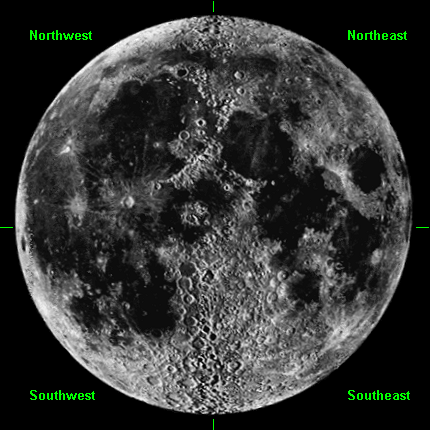
|
As we go though this lesson keep in mind that subtle differences in brightness can make a world of difference and the views I show you may not be what you see. So let's get started!
The northeast quadrant is dominated by three large maria.
|
Mare Serenitatis (Sea of Serenity) is the more northerly one approaching
the centerline of the Moon. Mare Crisium (Sea of Crises) is at the
extreme east side. Mare Tranquillitatis (Sea of Tranquillity)
is bordered by Mare Serenitatis to the northwest and Mare Fecunditatis
(Sea of Fertility) on the southeast which is mostly in the Moon's
Southern Hemisphere. Mare Vaporum (Sea of Vapors) is a small
dark mare southwest of Mare Tranquillitatis. Another long, thin
mare, Mare Frigoris (Sea of Cold), runs north of Tranquillitatis
and across to the Western Hemisphere.
On the southwest side of Mare Serenitatis lie the Haemus Mountains which rise to over 2.4 kilometers. Along the southern border of Mare Frigoris is one of the most beautiful mountain ranges on the Moon, the Alps! With a telescope you can find the Alpine Valley on the western border of this northeast quadrant. It cuts a full 130 kilometers through the Alps and a good telescope reveals a delicate rill along its floor as well as smaller valleys. Just to the south of the Alpine Valley is Mount Blanc, reaching a height of 3.5 kilometers. | 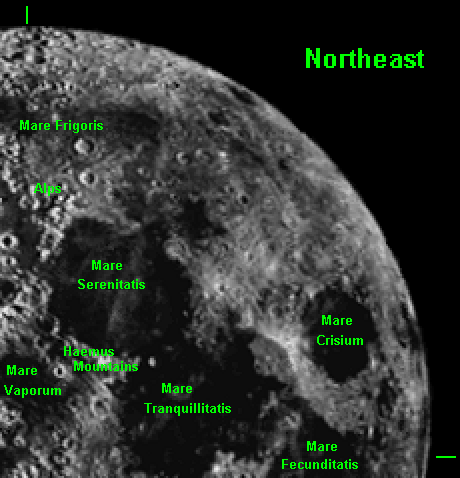
|
There are plenty of craters to choose from but most require a telescope in order to be thoroughly enjoyed.
| Crater Julius Caesar is irregularly shaped (not circular) and is just to the west of Mare Tranquillitatis. Its very dark floor causes it to stand out. On the floor of Mare Tranquillitatis, southeast of Julius and about half its size, is a nice (circular) crater called Arago. A good telescope shows "domes", elevated land, nearby. In the opposite direction, northwest of Julius, on the edge of Mare Vaporum is Manilius with walls made of a very reflective material that causes this crater to really stand out during a Full Moon. Between Mare Tranquillitatis and Mare Serenitatis is the crater Plinius. Between Mare Crisium and Mare Tranquillitatis is Proclus. It is the center of a nonsymmetric ray system and is a brilliant crater. Aristoteles is a large crater (100 kilometer in diameter with walls extending more than 3 kilometers above the floor) on the south edge of Mare Frigoris. Immediately south of Aristoteles lies the crater Eudoxus. There are several other large craters around Mare Frigoris including Endymion and Atlas along the west side of this mare and crater Bond on the north, opposite the Alpine Valley. | 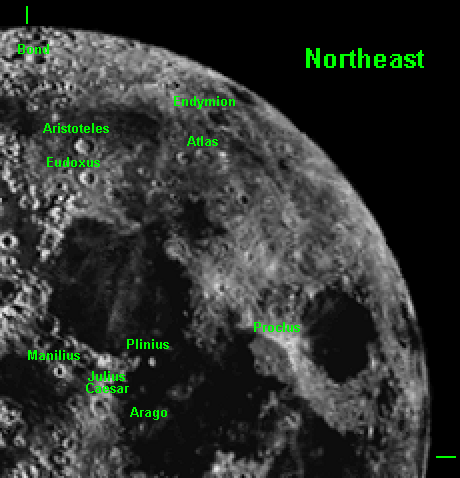
|
|
The northwest quadrant contains the gigantic Mare Imbrium (Sea
of Showers) which takes up most of the north section, up to the
Alps. The west end of this quadrant is covered by Oceanus Procellarum
(Ocean of Storms). Just to the south of Mare Imbrium is the tiny
mare called Sinus Aestuum (Bay of Heats), while on the other
side of Mare Imbrium is Sinus Roris (Bay of Dews).
Most of the southeast side of Mare Imbrium is defined by the Apennines Mountains, with the Carpathians Mountains making up the rest of the south side. The northeast of Mare Imbrium is defined by the Alps and most of the north of the mare is bordered by the Plato Uplands. Copernicus is the dominant crater in this quadrant. It's just south of the Carpathians. This crater is nearly 100 kilometers in diameter and a telescope shows its walls are terraced and, instead of a central peak, it has a complex mountain group of its own! During a Full Moon Copernicus' rays are the dominant feature in the Northern Hemisphere. | 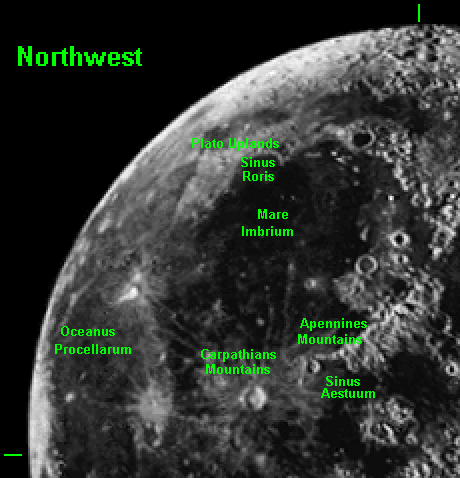
|
At the far western end of the Apennines is Eratosthenes, about half the size of Copernicus, with a high central peak and tall walls (seen with a good telescope).
| On the other side of Copernicus is Kepler, a small (35 kilometer diameter) crater with a very bright ray system of its own. Plato makes a significant dent (about 100 kilometers in diameter) into the eastern side of the Plato Uplands. It has a large walled plain of dark gray that makes it obvious, even during a Full Moon. Archimedes is slightly smaller than, and south of, Plato in Mare Imbrium. Its walled plains are obvious with a telescope. Just to the northeast of Archimedes (and also visible in our first quadrant images) are two smaller but distinct craters, Aristillus and Autolycus. Pythagoras crater is north of the Plato Uplands and it is so far north that it looks like an ellipse because the angle is so steep. But that angle also tends to bring out its best features (including a central peak, if you have a telescope). Aristarchus is a small (37 kilometer diameter) crater in Oceanus Procellarum with nice walls and central peak made of a highly reflective material that makes this crater the brightest crater on the Moon. (That doesn't count rays. Many other craters have brighter rays.) | 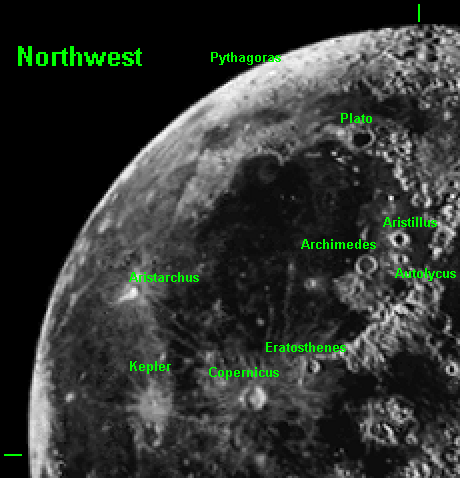
|
Sometimes the Earthshine (sunlight reflected off the Earth)
can slightly illuminate Aristarchus while it is still in shadow
causing some folks to think they have discovered an active volcano
on the Moon! 
|
The southwest has more highlands than mare but some very nice
maria are still found here. The largest mare here is Mare Nubium
(Sea of Clouds) which lies smack in the center of this quadrant.
Near its eastern side, and visible in a good telescope, runs the
"straight wall" which is actually a fault line - the
western side of the mare has fallen about 300 meters and the shadow
it produces gives the illusion of a straight wall. West of Nubium
is Mare Humorum (Sea of Humors). Oceanus Procellarum spills across
the equator and into this quadrant. Much of the area is full of
mountains, especially along the western rim. The Riphaean range
borders the western side of Mare Nubium.
The southern hemisphere is so dominated by highlands that it is difficult to pick out specific craters, but some just have to be mentioned. Tycho is about 80 kilometers wide but it is the dominant crater in this area because during a Full Moon its rays seem to spread into all four quadrants! | 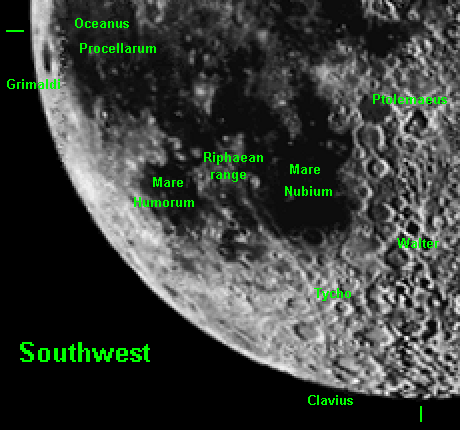
|
South of Tycho and close to the southern edge is the gigantic (230 kilometer wide) crater called Clavius. Its walls are over 4 kilometers tall so, when the terminator is near, this crater can be seen with the naked eye. Walter and Ptolemaeus are dark floored, walled plains craters at each end of a chain of craters that form a prominent group to the east of Nubium. Probably the darkest looking crater in this quadrant is Grimaldi at the far west edge near the Lunar Equator.
The southeast quadrant is also made up mostly of highlands.
|
Mare
Foecunditatis (Sea of Fertility), which starts in the north east
quadrant, continues down the south east side of the Moon. To the
west are the Pyrenees Mountains and west of them lies Mare
Nectaris (Sea of Nectar). On the extreme southeast edge is Mare
Australe (Sea of the South).
To the west of Mare Nectaris are three obvious craters. Theophilus is very deep with peaks rising 4.4 kilometers. It overlaps Cyrillus to its south, and farther south is Catharina. Piccolomi has very high walls which produce a striking relief when the terminus is near. This crater marks the beginning (or the end) of the Altai Scarp - not labeled in the photo but it's obvious running north towards Catharina. To the east of Mare Foecunditatis is the crater Langrenus which has walls about a kilometer high and two peaks near its center. During a Full Moon this crater is nothing more than a bright smear on the Moon. | 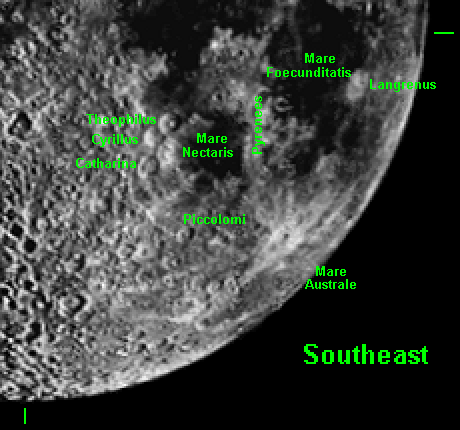
|
What about all those other things?
There are many (MANY) features on the Moon that you could spend years learning all about, but all I am trying to do in this lesson is to introduce you to some of the Moon's most obvious features. With the naked eye you will be able to see only the larger maria and a few of the most brilliant craters. I've thrown in a few other features just to remind you that the Moon has plenty to offer someone with binoculars or a telescope.
Get outside and have a look at the Moon as it goes through its phases and as its terminator brings the different features into view. You don't need magnification but if you can borrow some binoculars you will see wonderful sites.
See you next month.
Wishing you "Clear Skies".
Jamie  (Dr Love)
(Dr Love)








